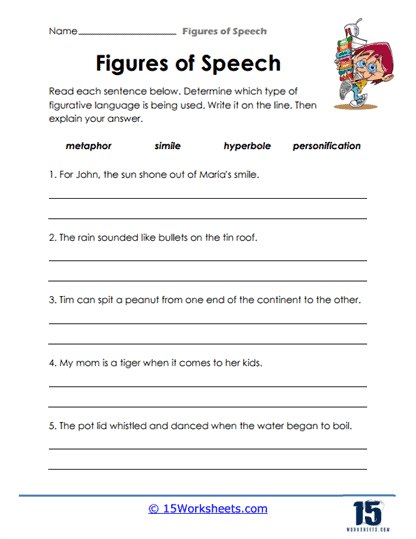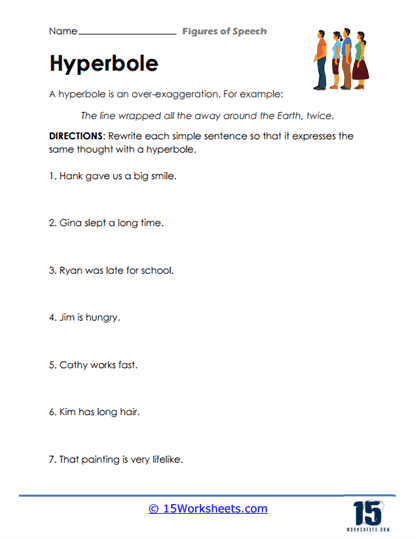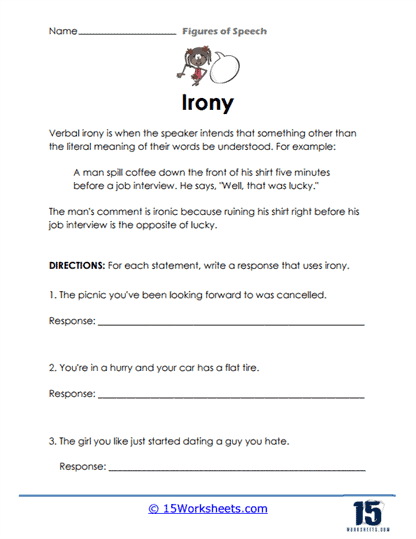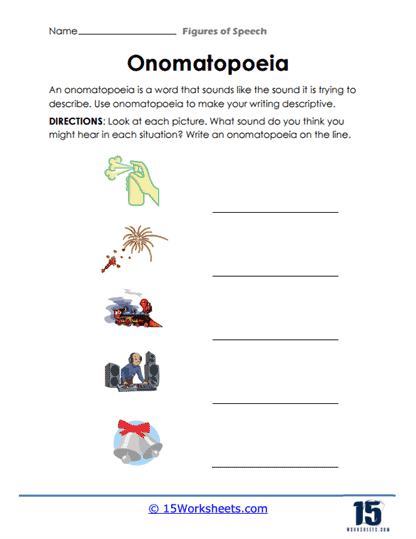Figures of Speech Worksheets
About These 15 Worksheets
These worksheets will help you learn and practice different types of figures of speech in language. Figures of speech are creative and imaginative ways of using language to add depth, vividness, and meaning to our expressions.
To explain figures of speech, let’s take an example of a figure of speech called a simile: “Her smile was as bright as the sun.” In this sentence, the comparison between the smile and the brightness of the sun creates a vivid image in our minds. Similes use “like” or “as” to compare two things that are different but share a similar characteristic.
Exploring figures of speech is like giving language a high-five for being clever, creative, and just a little bit weird-and these worksheets make sure students get their hands dirty (in the best possible metaphorical way). The Similes, Metaphors, and Personification worksheets are the gateway drugs to this world of figurative language. Here, students learn that a simile isn’t just something that pops up in bad love songs (“as cold as ice”), and that metaphors aren’t just something English teachers invent to make essays harder. These worksheets let students compare apples to oranges, give their dogs the power to feel existential dread, and see what happens when the moon decides to “smile.” It’s a crash course in seeing the world with weird, poetic goggles.
Then come the worksheets that make exaggeration a valid life choice: Hyperbole, Litotes, and Irony. Hyperbole is the drama queen of language-“I’m so hungry I could eat a planet”-and these worksheets encourage students to stretch the truth until it screams. Litotes, irony’s quieter cousin, teaches kids the art of the understated burn: “Not bad” might mean “pretty amazing,” or “You’re not entirely wrong” might mean “You’re very, very wrong.” The Irony worksheet throws students headfirst into the twisty world of sarcasm, unexpected outcomes, and Alanis Morissette misinterpretations. Together, these exercises help students master that oh-so-human skill of saying one thing and meaning another.
Next, students sharpen their ears and their wits with the Onomatopoeia, Puns, and Euphemisms worksheets. This trio is like the stand-up comedy segment of language learning. With Onomatopoeia, students dive into a splash, boom, crackle, and fizz of sound words that add flavor to any sentence. The Puns worksheet gets students to explore the painful joys of wordplay, where homophones become punchlines and groans become the goal. Euphemisms introduce the gentle art of saying awkward things without triggering social apocalypse-because sometimes it’s just more polite to say “passed away” than “died mid-bite at the buffet.”
For the deep thinkers (and future professional roasters), we’ve got Oxymoron, Antithesis, and Epigram worksheets. Oxymorons introduce students to phrases like “jumbo shrimp” and “clearly confused,” which make them question everything, including reality itself. Antithesis encourages them to find balance in contrast-“It was the best of times, it was the worst of times”-while Epigrams let them get witty and philosophical at the same time, dropping knowledge bombs like, “I can resist everything except temptation.” These aren’t just literary devices-they’re Jedi mind tricks that make language dance.
Finally, we arrive at the worksheets that bring everything full circle: Metonymy, Figures of Speech, and Matching. Metonymy gets kids thinking beyond the obvious-realizing that “the crown” might just mean “the monarch” and not an awkwardly shaped hat. The catch-all “Figures of Speech” worksheet reinforces the greatest hits and maybe throws in a few bonus tracks for good measure. The Matching worksheet, meanwhile, is a game show disguised as review, testing students’ ability to tell their synecdoches from their spoonerisms without phoning a friend. Altogether, these worksheets form a poetic boot camp-a training ground where students wrestle with meaning, charm their way through contradictions, and maybe, just maybe, fall in love with language.
What Are Figures of Speech?
Figures of speech are creative and imaginative expressions used in language to convey meaning in a non-literal way. They add depth, vividness, and emphasis to our communication by employing various linguistic devices. Here are five examples of figures of speech:
Simile – A simile is a figure of speech that compares two different things using “like” or “as” to highlight a shared characteristic.
For example: “He runs as fast as a cheetah” or “Her voice is as sweet as honey.”
Metaphor – Metaphor is a figure of speech that also compares two different things, but without using “like” or “as.” It directly states that one thing is another, creating a symbolic or imaginative connection.
For example: “Life is a journey” or “Her heart is made of stone.”
Hyperbole – Hyperbole is a figure of speech that involves exaggerated or extravagant statements not meant to be taken literally. It emphasizes a point through exaggerated language.
For example: “I’ve told you a million times!” or “I’m so hungry I could eat a horse!”
Personification – Personification is a figure of speech that attributes human qualities or actions to non-human things or abstract concepts. It brings inanimate objects or ideas to life by giving them human characteristics.
For example: “The sun smiled down on us” or “The wind whispered through the trees.”
Onomatopoeia – Onomatopoeia is a figure of speech that uses words that imitate or mimic the sounds they represent. It creates a vivid auditory effect.
For example: “The bees buzzed around the flowers” or “The thunder rumbled in the distance.”
How Do Authors Use This Technique?
Authors use figures of speech as a form of figurative language in literature for several reasons:
Enhancing Descriptions
Figures of speech bring richness and vividness to descriptions in literature. By using imaginative language, authors can paint a more detailed and engaging picture in the readers’ minds. Figures of speech add depth, color, and sensory imagery to the writing, making the scenes, characters, and settings come alive.
Figures of speech add depth and layers of meaning to the writing. By using creative language devices, authors can convey complex ideas, explore abstract concepts, or express multiple interpretations. Figures of speech provide a means to express deeper thoughts, symbolize themes, or convey subtle nuances that go beyond literal language
Evoking Emotions and Senses
Figures of speech have the power to evoke strong emotions in readers. By using expressive and metaphorical language, authors can tap into the readers’ emotions and create a deeper emotional connection. Figures of speech allow authors to convey complex emotions, create moods, and elicit specific feelings within readers.
Figures of speech appeal to the senses, making the reading experience more immersive. By incorporating sensory imagery, authors stimulate the readers’ senses of sight, sound, taste, touch, and smell. This sensory engagement enhances the readers’ immersion in the story and helps them connect with the narrative on a more visceral level.
Captivating and Memorable Writing
Figures of speech make writing more captivating and memorable. By employing imaginative and evocative language, authors create a distinct voice and style. Figures of speech engage readers’ attention, leaving a lasting impact on their memory. They make the writing stand out, capturing readers’ interest and drawing them into the world of the story.
Figures of speech serve specific literary purposes and effects. They can create irony, humor, suspense, or dramatic tension. Figures of speech allow authors to play with language, create wordplay, or develop unique metaphors that add richness to the narrative. These literary effects enhance the overall reading experience and make the literature more engaging and thought-provoking.















